-

人教版高中英语必修3Healthy Eating说课稿4篇
Language learning needs a context, which can help the learners to understand the language and then can product comprehensible output, so computer has the advantages to make the materials attractive.Part 3 Learning MethodsTask-based, self-dependent and cooperative learningPart 4 Teaching ProcedureStep One Lead-in“Interest is the best teacher.” Therefore, at the very beginning of the class, I should spark the students’ mind to focus on the centre topic “the band”. I’ll show some pictures of food to attract their attention and then bring some questions.Question:What kind of food they like?What should go into a good meal?The answers must relate to the diet. After this, the students will be eager to know something about a balance diet and this is the very time to naturally lead the class into Step 2Step 2 Reading for information: skimming and scanning In this step, I use Task-based Language Teaching method, which can give students a clear and specific purpose while skimming and scanning the context.Task 1 General ideaThe students will be asked to just glance at the title and the pictures of the passage, and then guess what they will read in the text. And they’ll be divided into groups of four to have a discussion.The purpose is to inspire the students to read actively, not passively. In addition, the task is to develop the students’ reading skill by making prediction and to encourage the students to express their thoughts in English and cooperate with each other.Task 2 Main idea of each paragraphCooperative learning can raise the students’ interest and create an atmosphere of achievement. Based on this theory, I divide the whole class into 4 groups to skim the whole text and get the main idea of each paragraph.

人教版高中英语必修4Working The Land说课稿3篇
Knowledge objectives:(1) to make Ss grasp the usage of words, expressions and sentence structures: statistics, struggle, thanks to, rid of, some patterns for persuasion, the “ing” form as subject and object;(2)to use learnt knowledge to persuade sb.Ability objectives:(1) to develop Ss’ reading skills(skimming, scanning, word guessing);(2) to improve Ss’ speaking, communicating and cooperating skills.Emotional objectives:to make Ss know the contribution of Yuan,and learn his spirit and his simple life time.Teaching important and difficult points:(1) some words, expressions and sentence structures mentioned above;(2)the content of the text;(3)training their reading and speaking skills.Teaching methods: CLT, TBLT,QT.Learning strategies: CLS, QLS, TBLS.Teaching procedures:Step 1 lead-in: (1) teacher plays a piece of recent news from CCTV about the harvest of the super hybrid rice, and ask students whether they know Yuan or not, and talk about him and his contribution.(2)Brain storm: let Ss describe Yuan in their minds including his appearance, his living condition and so on.Step 2 fast reading tasks:(1)teacher introduces Yuan and super hybrid rice(2)make Ss read the text as fast as possible with questions. Such as: what’s the general ideaof this passage? What’s Yuan’ dream? (skimming and scanning skill)Step 3 intensive reading tasks(1)let Ss read the text silently, find topic sentence of each paragraph and draw the difficult sentences and the knowledge what they don’t understand.(words guessing)(2)teacher and Ss talk about the important words, expressions and sentences together, and ask Ss to retell the content of the text.(summarizing and paraphrasing)(3)teacher summarize this part.(4) read again following the courseware.

人教版高中英语必修3The million pound bank note说课稿3篇
在接下来的细读环节,我套用了高考对阅读理解的考查方式设置了5个问题,分别为三个推理判断题,一个细节题和一个主旨大意题。学生需要对文章的内容进行分析、归纳、推理、猜测等高级思维活动才能做出正确的回答。【设计意图】这一过程是对学生进行细读的训练,培养学生获取特定信息和挖掘文章深层次信息的能力。第三环节:Intensive-reading (精读) 15′第三个环节精读,既是最重要的环节,也是突破本课重难点的关键。首先,让学生思考剧本中人物看到百万英镑前后的态度发生了怎样的变化。其次,让学生仔细阅读文章,找出可以表现人物态度变化的具体的语言和动作。最后,让学生总结人物的态度发生变化的根本原因是什么,从而引出Money Talks, 供学生思考。【设计意图】通过一系列的活动培养学生学习从人物的语言和动作探究人物的心理,使学生进一步体会戏剧语言的魅力,从而对文章背后所反映的社会问题进行思考,也为下一步的讨论环节做好铺垫。

人教版高中英语必修5First aid说课稿6篇
In this class, I have 3 teaching aims, that is, knowledge aims, ability aims and emotion aims.1) Knowledge-Teach students new words and expressions, such as temporary, bleed,sprain choke, first aid, fall ill and so on.-Enable students to have a better understanding for some basic knowledge of first aid.2) Ability-Train students’ speaking, reading and writing abilities by different teaching activities, such as skimming, comprehending, team work, role play, retelling and writing.-Develop students’ reading strategy on how to move general idea to specific information.3) Emotion-Promote students’ awareness of giving first aid.- Cultivate students’ creativities.Then let’s come to my teaching methods and activities.III. Teaching methods and activities:To achieve different teaching aims, various kinds of teaching methods and activities will be adopted throughout this period, such as TBL (task-based learning), skimming, team work, brainstorm and others, which can offer students opportunities to fulfill tasks in which they can use language to achieve a specific outcome.IV. Teaching aids:Computer and blackboardV. Teaching important points:1) Make students have a clear mind for the structure of the text.2) Help students understand the theme of the text.VI. Teaching difficulties:1) So many new words may affect students’ understanding.2) How to get students to know about the functions of the skin and thecauses, characteristics and treatments for different degree burns,and the knowledge about giving first aid. VII. Blackboard design:

人教版高中英语必修5Great scientists说课稿4篇
通过写文章梗概,培养学生综合运用语言的能力,学习用恰当的英语描述科学家的故事。这是本课的教学难点。教师可以使用完形填空的方式来帮助学生整理语篇,从而来降低难度。本课的教学重点的突破方法是:在阅读前,让学生初步了解得出科学观点所需要的基本程序,从而轻松而自然地导入文章的阅读;在阅读过程中,由易到难设计快速阅读和精读的问题,层层推进各种阅读活动,让学生对阅读内容从整体感知到细节理解,最后深层读懂整篇文章,同时加强阅读策略的指导,让每个学生都主动参与课堂教学活动,最终达到提高阅读能力的目的。Step 4 Post-readingGroup Activities四人小组共同合作,在老师的适当指导下,就以下2个问题展开讨论,让学生就所知、所学、所感和所想融入话题,然后抽若干同学代表作小组发言。1. What do you think about John Snow, and what should we learn from him?2. Cholera was 19th century disease, which two diseases are similar to cholera today? Why?

人教版高中英语必修5Life in the Future说课稿5篇
Good afternoon, everyone. It’s my great pleasure to be here sharing my lesson with you. The content of my lesson is Senior English for China Book5 Unit 3 Life in the Future. I’ll be ready to begin this lesson from six parts: Analysis of the teaching material, Analysis of the students, Teaching aims and important and difficult points, Teaching methods and aids, Teaching procedures, and Blackboard design. First, let me talk about the teaching material.Part 1 Analysis of the Teaching Material:This unit is about what human beings’ life will be like in about one thousand years. By studying of this unit, we’ll Enable the students to know the changes in humans’ life and some new inventions bringing about the change and develop the interest in science. This lesson plays an important part in the English teaching in this unit. This is an important lesson in Book Five. From this lesson, it starts asking the Ss to grasp contents of each passage. Therefore, this lesson is in the important position of the teaching material. If the Ss can learn it well, it will be helpful to make the Ss learn the rest of this unit.Part 2 Analysis of the SsAs Senior2 Ss, they are at different levels of English fluency, some of them have lost interest in English. So during the lesson, I arrange a variety of activities to let all of them join in to attract their interest and let them be confident and taste the joy of success.

人教版高中英语必修5Making the news说课稿4篇
今天我们来介绍一下必修五第四单元的授课方式。这个单元的题目是Making the news。应该是学生比较感兴趣的话题,学生往往对新闻工作充满好奇,所以我们可以利用这个机会多设计一些师生互动和学生互动,来激发起学习的积极性,提高学习效率。同时我们可以利用这个单元不仅帮助学生掌握语言知识,培养语言能力,同时让其了解新闻工作的重要性,培养起社会智能感。这个单元分为六个课时,它的教学目标是这样的:语言目标是掌握词汇表中的常用单词和短语,掌握倒装句的一些基本用法。 技能目标是能初步掌握约会的基本句型并在真实的场景下正确运用。新闻报道类文章的写作技能。采访的基本规范和沟通技能。情感目标是对新闻报道的客观性和真实性有更好的理解。对新闻记者的职业有更深入的了解,并能体会其工作的重要性。下面我们来介绍一下第一课时的授课方式,第一课的教学目标是这样的第一课时的教学目标语言目标:单词:Occupation, journalist, editor, photographer, curious, personality, enthusiasm

人教版高中英语必修5The United Kingdom说课稿4篇
Teaching Aims:Knowledge 1. Get the students to learn the useful new words and expressions in this section. Aims:2. Let the students learn about how the UK was formed and the four groups of invaders.1. Develop students’ reading ability and let them learn different Ability reading skills. Aims:2. Enable students to learn to talk about the United Kingdom and the Union Jack Emotional 1. Let students know more about the UK2. Develop students’ sense of cooperative learning Aims:Teaching Important Points:1. Let the students learn about the countries of the United Kingdom and the Union Jack2. Get the students to read the passage and know about how the UK was formed and the four groups of invaders.3. Have the students learn different reading skills.Teaching Difficult Ponts:1. Develop students’ reading ability.2. Enable students to talk about the United Kingdom and the Union Jack.3. Let students learn how the UK was formed geographically and historically.Teaching Methods:Showing pictures, asking, exercising, listening, reading etc.Teaching Aids:A computer,a projector and a blackboard.Teaching Procedures: 1) Show a map of the world, ask students the following questions:Where is the UK?What’s the full name of the UK?2) Ask the students work in pairs to do the quiz on Page 9.Do you want to test how many things you know about the United Kingdom? Let’s have a small test.Using the map on P9, students answer the following questions:?How many countries does the UK consist of? What are they??England is divided into three main areas. Do you know what they are? 1) Scanning (10Minutes )Let the students hold the questions asked in pre-reading and read the passagequickly and then let them do the following exercise.Join lines to the right answer.
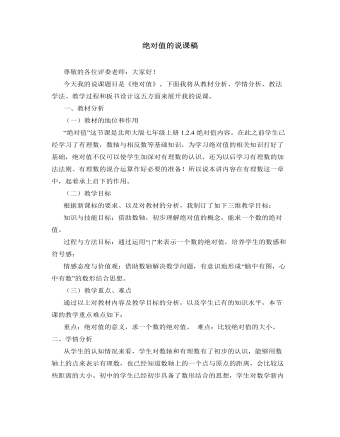
北师大初中数学七年级上册绝对值的说课稿
(三)学以致用,巩固新知为巩固本节的教学重点我再次给出三道问题: 1)绝对值是7的数有几个?各是什么?有没有绝对值是-2的数?2)绝对值是0的数有几个?各是什么? 3)绝对值小于3的整数一共有多少个?先让学生通过小组讨论得出结果,通过以上练习使学生在掌握知识的基础上达到灵活运用,形成一定的能力。(四)总结归纳,知识升华小结时我也将充分发挥学生学习的主动性,发挥教师在教学的启发引导作用,和学生一起合作把本节课所学的内容做一个小结。(五)布置作业,拓展新知布置作业不是目的,目的是使学生能够更好地掌握并运用本节课的内容。所以我会布置这样一个作业:请学生回家在父母的帮助下,找出南方和北方各三个城市的温度,并比较这些温度的大小,并写出每个温度的绝对值进行比较
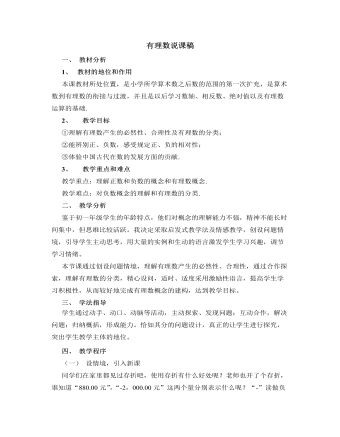
北师大初中数学七年级上册有理数说课稿
1、 教材的地位和作用本课教材所处位置,是小学所学算术数之后数的范围的第一次扩充,是算术数到有理数的衔接与过渡,并且是以后学习数轴、相反数、绝对值以及有理数运算的基础.2、 教学目标①理解有理数产生的必然性、合理性及有理数的分类;②能辨别正、负数,感受规定正、负的相对性;③体验中国古代在数的发展方面的贡献.3、 教学重点和难点教学重点:理解正数和负数的概念和有理数概念.教学难点:对负数概念的理解和有理数的分类.二、 教学分析鉴于初一年级学生的年龄特点,他们对概念的理解能力不强,精神不能长时间集中,但思维比较活跃。我决定采取启发式教学法及情感教学,创设问题情境,引导学生主动思考,用大量的实例和生动的语言激发学生学习兴趣,调节学习情绪。
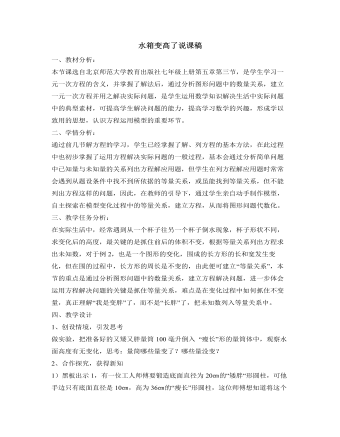
北师大初中数学七年级上册水箱变高了说课稿
一、教材分析:本节课选自北京师范大学教育出版社七年级上册第五章第三节,是学生学习一元一次方程的含义,并掌握了解法后,通过分析图形问题中的数量关系,建立一元一次方程并用之解决实际问题,是学生运用数学知识解决生活中实际问题中的典型素材,可提高学生解决问题的能力,提高学习数学的兴趣,形成学以致用的思想,认识方程运用模型的重要环节。二、学情分析:通过前几节解方程的学习,学生已经掌握了解、列方程的基本方法,在此过程中也初步掌握了运用方程解决实际问题的一般过程,基本会通过分析简单问题中已知量与未知量的关系列出方程解应用题,但学生在列方程解应用题时常常会遇到从题设条件中找不到所依据的等量关系,或虽能找到等量关系,但不能列出方程这样的问题,因此,在教师的引导下,通过学生亲自动手制作模型,自主探索在模型变化过程中的等量关系,建立方程,从而将图形问题代数化。
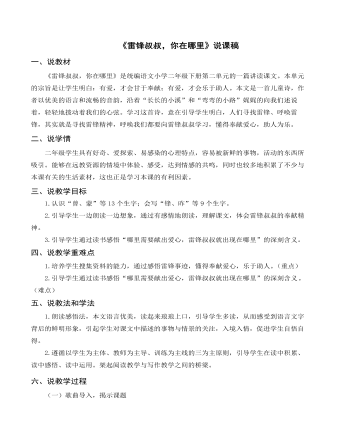
(说课稿)《雷锋叔叔,你在哪里》部编人教版二年级上册语文
三、说教学目标1.认识“曾、蒙”等13个生字;会写“锋、昨”等9个生字。2.引导学生一边朗读一边想象,通过有感情地朗读,理解课文,体会雷锋叔叔的奉献精神。3.引导学生通过读书感悟“哪里需要献出爱心,雷锋叔叔就出现在哪里”的深刻含义。四、说教学重难点 1.培养学生搜集资料的能力,通过感悟雷锋事迹,懂得奉献爱心,乐于助人。(重点)2.引导学生通过读书感悟“哪里需要献出爱心,雷锋叔叔就出现在哪里”的深刻含义。(难点)五、说教法和学法1.朗读感悟法,本文语言优美,读起来琅琅上口,引导学生多读,从而感受到语言文字背后的鲜明形象,引起学生对课文中描述的事物与情景的关注,入境入情,促进学生自悟自得。2.遵循以学生为主体、教师为主导、训练为主线的三为主原则,引导学生在读中积累、读中感悟、读中运用。架起阅读教学与写作教学之间的桥梁。
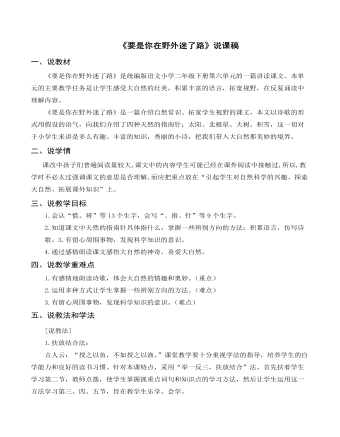
(说课稿)《要是你在野外迷了路》部编人教版二年级上册语文
六、说教学过程(一)创设情境,激趣导入 一堂课的开始,为了使学生尽快地进入学习状态,在情境创设中,应该做到新颖,要让学生感受到一种新的情境,从而产生好奇心,达到集中注意力的目的。教学开始,我首先创设情境,提出了两个问题:1.如果你在大街上迷路了,你会怎么做?2.如果你在野外迷了路,你又会怎么做?【设计意图】这两个问题的提出让学生区分在不同的地点迷了路要用不同的方法。然后我顺势导入课文:我们来学习课文,看看如果在野外迷了路,有什么办法分辨方向。(二)初读课文,整体感知 1.让学生自由读课文,要求把字音读准,把句子读通顺。然后老师范读一遍,让学生注意听老师是怎么读的,如字音、节奏等。2.再次自由读课文,按着老师的方法读诗歌,然后把本课的生字读一遍。【设计意图】这样,学生对于课文的生字和大概内容就有了一个整体印象,培养了他们的自学能力。
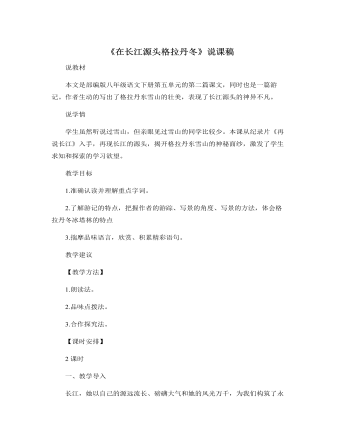
部编版语文八年级下册《在长江源头各拉丹冬》说课稿
说教材本文是部编版八年级语文下册第五单元的第二篇课文,同时也是一篇游记。作者生动的写出了格拉丹东雪山的壮美,表现了长江源头的神异不凡。说学情学生虽然听说过雪山,但亲眼见过雪山的同学比较少。本课从纪录片《再说长江》入手,再现长江的源头,揭开格拉丹东雪山的神秘面纱,激发了学生求知和探索的学习欲望。教学目标1.准确认读并理解重点字词。2.了解游记的特点,把握作者的游踪、写景的角度、写景的方法,体会格拉丹冬冰塔林的特点3.揣摩品味语言,欣赏、积累精彩语句。教学建议【教学方法】1.朗读法。2.品味点拨法。3.合作探究法。【课时安排】2课时一、教学导入长江,她以自己的源远流长、磅礴大气和她的风光万千,为我们构筑了永恒的大江之美,启发着一代又一代华夏儿女的激情与灵感,赢得了世人发自肺腑的赞美和感叹。今天我们来学习《在长江源头各拉丹冬》这篇文章,欣赏长江的源头各拉丹冬这片雪域高原的壮美景色。
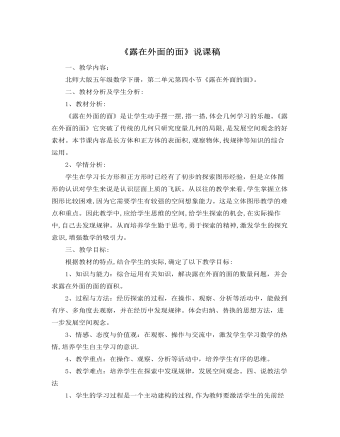
北师大版小学数学五年级下册《露在外面的面》说课稿
依据本节课的知识结构与学生的认知规律,这节课我是这样安排的:第一个环节:谈话交流,引入课题。先出示一个正方体。让学生说一说对正方体的认识,再让学生观察能看到几个面?分别是什么面?接着教师引出,既然同学们最多只能看见正方体的3个面,所以老师说这个正方体只有3个面露在外面。经过学生思考,确定还有两个面露在外面,然后出示课题-----露在外面的面。第二个环节:探索新知,发现规律。在这个环节中,我首先呈现一个摆放在墙角的小正方体:让孩子们观察有几个面露在外面,是哪几个面?这是一个简单的问题,学生通过观察都可以看到露在外面的面分别是上面,前面和侧面。然后计算露在外面的面的面积。学生自己尝试计算时,都能找到方法:计算一个小正方形的面积再乘以露在外面的面数就可以了。
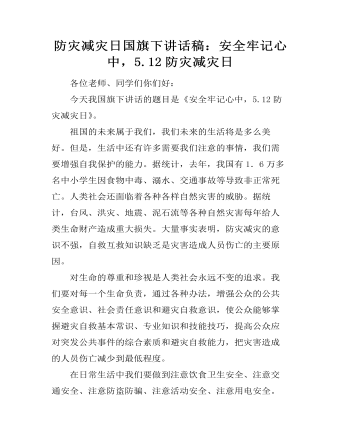
防灾减灾日国旗下讲话稿:安全牢记心中,5.12防灾减灾日
各位老师、同学们你们好:今天我国旗下讲话的题目是《安全牢记心中,5.12防灾减灾日》。祖国的未来属于我们,我们未来的生活将是多么美好。但是,生活中还有许多需要我们注意的事情,我们需要增强自我保护的能力。据统计,去年,我国有1.6万多名中小学生因食物中毒、溺水、交通事故等导致非正常死亡。人类社会还面临着各种各样自然灾害的威胁。据统计,台风、洪灾、地震、泥石流等各种自然灾害每年给人类生命财产造成重大损失。大量事实表明,防灾减灾的意识不强,自救互救知识缺乏是灾害造成人员伤亡的主要原因。对生命的尊重和珍视是人类社会永远不变的追求。我们要对每一个生命负责,通过各种办法,增强公众的公共安全意识、社会责任意识和避灾自救意识,使公众能够掌握避灾自救基本常识、专业知识和技能技巧,提高公众应对突发公共事件的综合素质和避灾自救能力,把灾害造成的人员伤亡减少到最低程度。
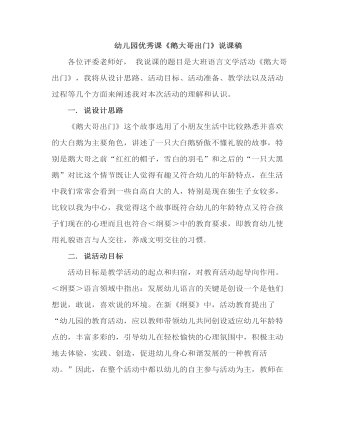
幼儿园优秀课《鹅大哥出门》说课稿
一. 说设计思路 《鹅大哥出门》这个故事选用了小朋友生活中比较熟悉并喜欢的大白鹅为主要角色,讲述了一只大白鹅骄傲不懂礼貌的故事,特别是鹅大哥之前“红红的帽子,雪白的羽毛”和之后的“一只大黑鹅”对比这个情节既让人觉得有趣又符合幼儿的年龄特点,在生活中我们常常会看到一些自高自大的人,特别是现在独生子女较多,比较以我为中心,我觉得这个故事既符合幼儿的年龄特点又符合孩子们现在的心理而且也符合<纲要>中的教育要求,即教育幼儿使用礼貌语言与人交往,养成文明交往的习惯.
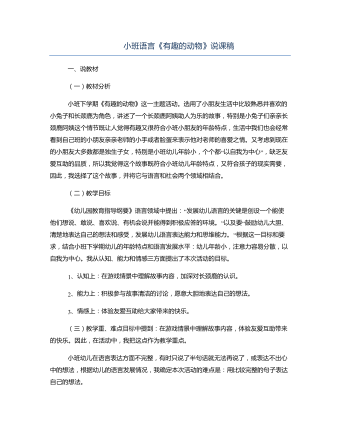
小班语言《有趣的动物》说课稿
《幼儿园教育指导纲要》语言领域中提出:“发展幼儿语言的关键是创设一个能使他们想说、敢说、喜欢说、有机会说并能得到积极应答的环境。”以及要“鼓励幼儿大胆、清楚地表达自己的想法和感受,发展幼儿语言表达能力和思维能力。”根据这一目标和要求,结合小班下学期幼儿的年龄特点和语言发展水平:幼儿年龄小,注意力容易分散,以自我为中心。我从认知、能力和情感三方面提出了本次活动的目标。1、认知上:在游戏情景中理解故事内容,加深对长颈鹿的认识。2、能力上:积极参与故事清洁的讨论,愿意大胆地表达自己的想法。3、情感上:体验友爱互助给大家带来的快乐。

大班美术欣赏《向日葵》说课稿
《向日葵》是法国伟大的画家凡高的作品。观者在观看此画时。无不为其中激动人心的画面效果而感应,心灵为之震颤,激情也喷发而出.无不跃跃欲试,共同融人到凡高丰富的主观感情中去。总之,凡高笔下的向日葵不仅仅是植物,而是带有原始冲动和热情的生命体。在《向日葵》这幅作品中,值得幼儿欣赏和学习的是:画面中鲜明亮丽的色彩和极富特色的线条,感受画面传达出来的强烈、炙热的感情。然而对于城市的大班幼儿来说,孩子缺乏对“向日葵”这种植物的真实的感知,孩子不知道向日葵这种植物的外形、色彩、特征以及它的象征。而这些恰恰正是欣赏《向日葵》这幅作品的经验基础。新《纲要》强调:“幼儿的学习要来源于幼儿的生活,以生活为基础,建立在生活之上。”
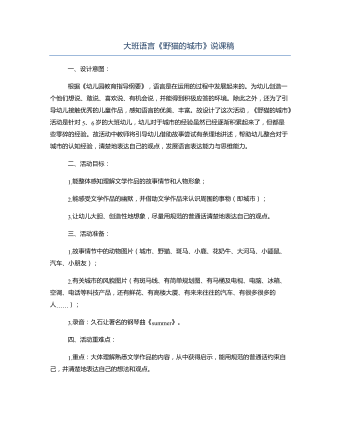
大班语言《野猫的城市》说课稿
大班幼儿处于5、6岁左右,语言发展还是稍微欠缺,而且过不了多久就得进入学前班或者小学阶段。所以,这个阶段不仅是语言发展的生理关键期,也是知识奠基的重要阶段。他们比小班、中班幼儿更主动求知,但知识经验大都是根据自己的好奇与无数的巧合而获得的,都是很零碎的。除此之外,在语言表达上还不是很规范,特别是普通话方面才启蒙不久。理论上说,<4岁的幼儿重在感知语言能力;4-5岁重在感知和理解词义;5-6岁重在培养讲述。所以,通过这次语言活动,要根据大班幼儿在语言方面的缺失、幼儿需要达到的语言目标,建立一个民主、和谐的师生关系,给幼儿一个较为轻松的语言环境,培养幼儿对语言的表述能力与思维能力,能够有条理地讲述自己的观点,并且能在老师引导下,有意识的注意字音的准确性,尽量用标准的普通话规范自己。并借助作品来认识周围世界(即作品中的城市)